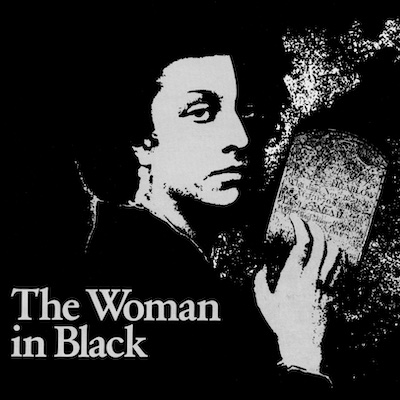The Woman in Black: Articles
The Articles section includes articles and interviews with the creators of the original production of The Woman in Black - the author Susan Hill, the adaptor, Stephen Mallatratt and the director, Robin Herford - as well as other relevant articles. Click on a link in the box below to access the relevant article.This article by the theatre's archivist, Simon Murgatroyd, looks at the life & achievements of The Woman in Black's adaptor, Stephen Mallatratt. It was first published in the programme for the Stephen Joseph Theatre's revival of The Woman in Black in 2015 as part of the company's 60th anniversary celebrations
Remembering Stephen Mallatratt
Other Articles

The Woman in Black
In 1974, Stephen joined the Library Theatre in Scarborough as an actor, his first role playing John in the world premiere of Alan Ayckbourn’s Absent Friends.
He was a prolific actor with the company appearing in 27 different productions over the years notably including the world premieres of Alan Ayckbourn’s Bedroom Farce and Confusions.
But it was as playwright that Stephen became best known and it was Alan Ayckbourn who encouraged him to put pen to paper. His first play, An Englishman’s Home, was produced at the Library Theatre in October 1975 and Alan described it as a “practically perfect first play”. It subsequently went on a UK tour in repertoire with Alan Ayckbourn’s latest play Just Between Ourselves - quite a showcase for a new writer.
Stephen would go on to write The Chimes (1975), Mother Country (1976) and Saint Trixie (1979) before leaving the company in 1979. He returned in 1985 and, appointed as Resident Writer, he wrote Touch Wood And Whistle (1986), Pay Day Night (1986),The Haunt Of Mr Fossett (1988) and The Turn Of The Screw (1988); tantalisingly a play called Wonderland was announced for the 1987 season but never produced.
But it is for one play he is best remembered; his adaptation of Susan Hill’s The Woman In Black for the studio at the Stephen Joseph Theatre In The Round in 1987. The Artistic Director Robin Herford - Alan Ayckbourn being on a two year sabbatical at the National Theatre - wanted a “Christmas stocking filler” and asked Stephen for suggestions for a studio play with no more than four actors and no substantial set.
Stephen suggested adapting Hill’s novella, he was a great fan having read it the previous year whilst on holiday.
“A Greek beach must be the most inappropriate place to read a story like this! But that was where I read it, and, like most people who have read it, I was very struck by it. It was a bit of a nutty idea, really. But when I got back I wrote to Susan Hill saying, either would she consider adapting it, or would she let me?”
Neither Robin - noting it was a period piece with a dozen characters - nor Susan were convinced by the idea. Susan replied to Stephen in a letter still held by the Stephen Joseph Theatre.
“I’m amazed that you should think it remotely possible to do the book on stage, but thinking of what has been done in dramatic form, which would seem pretty unlikely, I imagine there must be a way, if you think so!”
Unperturbed Stephen wrote the play for - famously - just two actors, minimal staging and a challenging sound-plot. With the author’s approval and a script in place, Robin took on directing duties with design by Michael Holt, lighting by Mick Thomas and sound by Jackie Staines. The two acting roles were taken by Jon Strickland as The Actor and Dominic Letts as Kipps.
The play opened on Friday 11 December 1987 in what Robin later described as “a rough and ready” production. Despite middling reviews, audiences fell in love with the show, so much so that Stephen recalled the theatre could barely cope with demand.
“The next day [after the reviews] something happened that you always hope will, and so seldom does. The box office phones started to ring and queues began to form. By the end of
the short run we’d squeezed in extra chairs for every performance and we’d added three or four late night performances, selling out every time.”
The play ran for only three weeks, but it had been successful far beyond anyone could ever have imagined or hoped. Within two years it was produced in the West End where it has remained ever since.
Stephen left the company in 1988 and forged a successful career in television, notably writing for there popular soap opera Coronation Street for a dozen years during the 1980s and 1990s - which interestingly had two SJT connections. Stephen was invited to join the show’s script-writing team by then producer Mervyn Watson who Stephen had first met at this theatre, when Mervyn was Associate Director. Stephen also notably brought his friend the actor, David Nielson, into the soap opera and helped develop the much loved character of Roy Cropper; David also appeared in the world premiere of Stephen’s play Touch Wood & Whistle in Scarborough in 1986.
Tragically, Stephen’s life was cut short when on 22 November 2004 he died from leukaemia.
His legacy, though, is a play known throughout the world which continues to thrive.
By reviving The Woman In Black as part of its 60th Anniversary, the Stephen Joseph Theatre is not only celebrating an extraordinary play which began life here, but also a playwright whose contribution to this theatre should never be under-estimated nor forgotten.
"The flesh shrank from her bones, the colour was drained from her, she looked like a walking skeleton - a living spectre."
Article by and copyright of Simon Murgatroyd, all rights reserved 2022. Please do not reproduce without permission of the copyright holder.